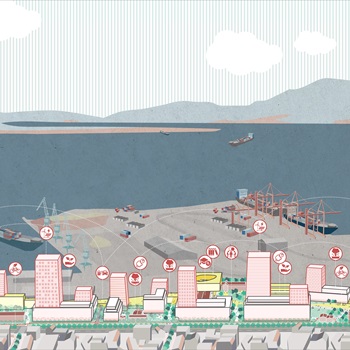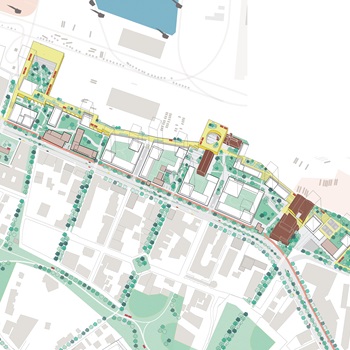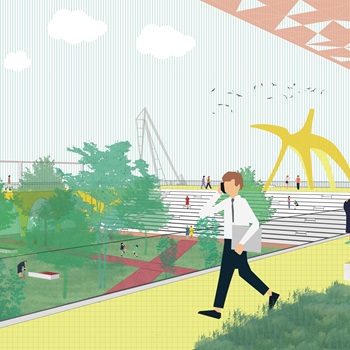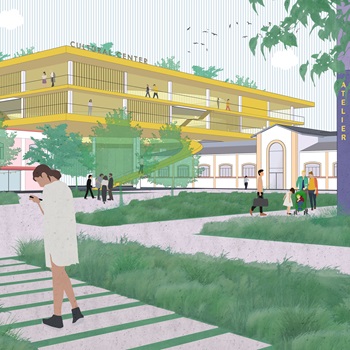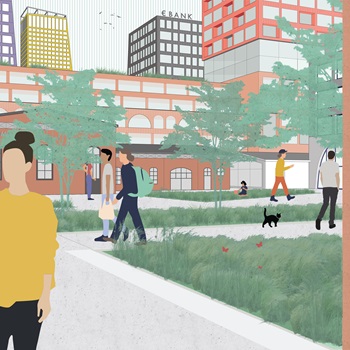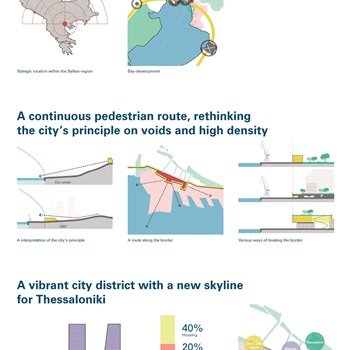
6th prize: Interview with BURA urbanism office
1) Please tell us a few words about you and what motivated you to participate in the competition of Arxellence 2. Did you ever undertake/design a similar project (CBD) in the past?
a. Tell us a few words about the team that worked on the proposal.
b. How were you informed about the competition of ArXellence 2?
c. Did you ever undertake/design a similar project in the past?
Our team consists of current and former members of the BURA urbanism office. BURA urbanism is an internationally operating office for urban design, research and (landscape) architecture based in Amsterdam. With an interdisciplinary and international team we work on solutions for the sustainable development and transformation of the urban landscape. We focus on various topics, such as new residential and working districts, heritage transformation and healthy urbanization. We work on many urban densification projects, mainly in the Netherlands.
By participating in this competition we welcomed the challenge to apply our prior knowledge and expertise on a different context. Many members of our team work on a mixed used high density project in Utrecht (the Netherlands), called: Merwede. This is a 24 hectares inner-city development, about 6.000 new dwellings, mixed program, public services, a park and car free.
We were informed about the competition through social media channels. Additionally, Martha Seitanidou, one of our team members, who had a leading role in the design process and initiated our participation, is from Greece. Specifically from the northern part of the country. She was our local expert and her knowledge of the local culture, history and landscape, was a factor that contributed in having a tailor-made and realistic proposal.
Besides, our international team members are from, Taiwan, Portugal and the Netherlands.
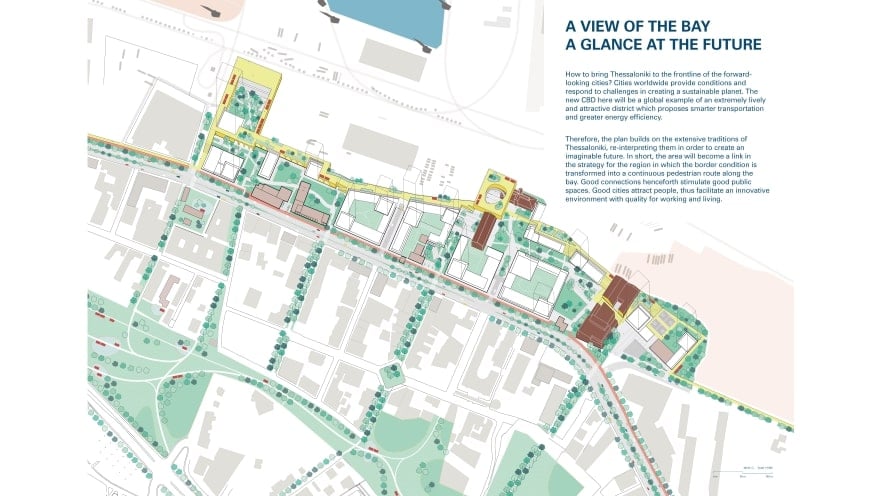
2) Could you give us a description of your proposal? How did you approach the project and what was the main idea of your design?
a. Describe in a few words the structure of the CBD you designed (the main characteristics of your synthesis).
b. Describe the main idea of your proposal.
c. What difficulties did you face?
d. What would you say is the most innovative feature of your proposal?
Our proposal “A view of the bay/ A glance at the future” has the following design question as a starting point: How to create a lively Central Business District that is an area with high density and a pleasant living and working environment?
In order to answer this question, we create an agenda with certain main points. We attempt to link multiple nodes along the bay of Thermaikos and we do that by proposing a continuous pedestrian route. We give new life to existing buildings that are significant part of the city’s history. In addition to that, we create an area with high density and mixed functions that at the same time is a vibrant city district with a new skyline.
We start by zooming out and identifying the city of Thessaloniki as a major HUB in the Balkan region. In the scale of the city, the project site is one of the multiple nodes within the prospering bay of Thermaikos. We propose a public promenade that connects the historic center with the site and the greater bay. Our proposal creates a continuity to the new waterfront, which is one of the biggest projects lately implemented in Thessaloniki. In the city center, we observe a lack of open spaces that is compensated by a stunning view of the bay. We attempt a re-interpretation of the city’s principle and we propose a raised pedestrian route that offers a view over the busy port.
In terms of building typologies, the most common building in Thessaloniki -like in all Greek cities- is the typology of Polykatoikia. This is a residential building with an average height of six layers and an active plinth. We attempt to combine this typology with the high-rise; a series of higher towers which creates a new layer in the area and introduces a new skyline for Thessaloniki.
We strongly believe that an innovation district should include a mix of programs with flexibility and create a living lab itself. The proposed mix consists of 40% housing, 40% offices, making industry and 20% cultural functions, sports and flexible program. This mix ensures liveliness during the day (and night) and encourages interaction between people and thus innovation. So, we achieve a lively city district with meeting places for all kinds of people.
We see a sustainable and high mobility ambition regarding the accessibility of the area. The focus is on pedestrians, cyclists and public transport and the area will be mainly car-free. The 26th October Street will be transformed into a city boulevard with a few turns into the area, in order to reach the parking facilities. In this way we create safe and pleasant public spaces, including squares, parks and streets where pedestrians and cyclists have priority. Additionally, we propose green connections to the opposite neighborhood and parks that achieve good integration in the surroundings. Within the urban framework, we propose a series of architectural typologies merging the courtyard city block with the high-rise buildings. We achieve the densification without losing the idea of city in eye level and we also maintain the relation with the existing architectural typologies. The result is an appealing skyline offering variation between private-public spaces and semi-public spaces. This allows a phased development which can be applied to the surrounded neighborhood (and the opposite of the 26th October Street) as well. Our proposal “A view of the bay/ A glance at the future” has the following design question as a starting point: How to create a lively Central Business District that is an area with high density and a pleasant living and working environment?
In order to answer this question, we create an agenda with certain main points. We attempt to link multiple nodes along the bay of Thermaikos and we do that by proposing a continuous pedestrian route. We give new life to existing buildings that are significant part of the city’s history. In addition to that, we create an area with high density and mixed functions that at the same time is a vibrant city district with a new skyline.
We start by zooming out and identifying the city of Thessaloniki as a major HUB in the Balkan region. In the scale of the city, the project site is one of the multiple nodes within the prospering bay of Thermaikos. We propose a public promenade that connects the historic center with the site and the greater bay. Our proposal creates a continuity to the new waterfront, which is one of the biggest projects lately implemented in Thessaloniki. In the city center, we observe a lack of open spaces that is compensated by a stunning view of the bay. We attempt a re-interpretation of the city’s principle and we propose a raised pedestrian route that offers a view over the busy port.
In terms of building typologies, the most common building in Thessaloniki -like in all Greek cities- is the typology of Polykatoikia. This is a residential building with an average height of six layers and an active plinth. We attempt to combine this typology with the high-rise; a series of higher towers which creates a new layer in the area and introduces a new skyline for Thessaloniki.
We strongly believe that an innovation district should include a mix of programs with flexibility and create a living lab itself. The proposed mix consists of 40% housing, 40% offices, making industry and 20% cultural functions, sports and flexible program. This mix ensures liveliness during the day (and night) and encourages interaction between people and thus innovation. So, we achieve a lively city district with meeting places for all kinds of people.
We see a sustainable and high mobility ambition regarding the accessibility of the area. The focus is on pedestrians, cyclists and public transport and the area will be mainly car-free. The 26th October Street will be transformed into a city boulevard with a few turns into the area, in order to reach the parking facilities. In this way we create safe and pleasant public spaces, including squares, parks and streets where pedestrians and cyclists have priority. Additionally, we propose green connections to the opposite neighborhood and parks that achieve good integration in the surroundings. Within the urban framework, we propose a series of architectural typologies merging the courtyard city block with the high-rise buildings. We achieve the densification without losing the idea of city in eye level and we also maintain the relation with the existing architectural typologies. The result is an appealing skyline offering variation between private-public spaces and semi-public spaces. This allows a phased development which can be applied to the surrounded neighborhood (and the opposite of the 26th October Street) as well.
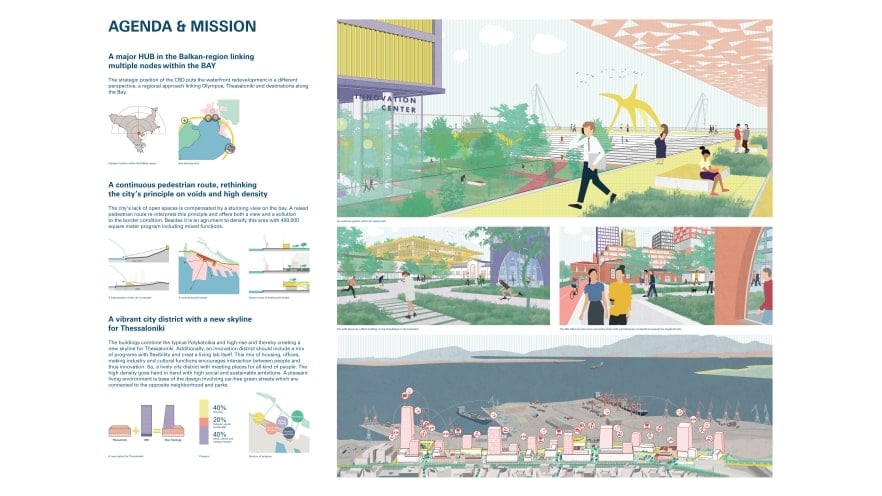
3) What do you think made your idea stand out and why? What are the experiences you gained from the competition of ArXellence 2?
The public promenade is one of the proposal’s key elements that, as a strong gesture, connects the site with the rest of the Thermaikos bay, activates the border with the busy harbor, provides views of the bay and creates a public space for all people. Our proposal with its mixed program, variation of public spaces and building typologies, is an original and robust scheme with great potential for further development. Our participation in this competition was a great experience that gave us the motivation to study the Greek context, as well as explore the special qualities of the site and the city. We end up with an innovative proposal that can bring Thessaloniki to the frontline of the forward-looking cities.
Concluding, we are optimistic that this competition will pave the way for the regeneration of this urban area and offer the city of Thessaloniki a CBD that could be a global example of a lively, attractive, smart and sustainable district!
